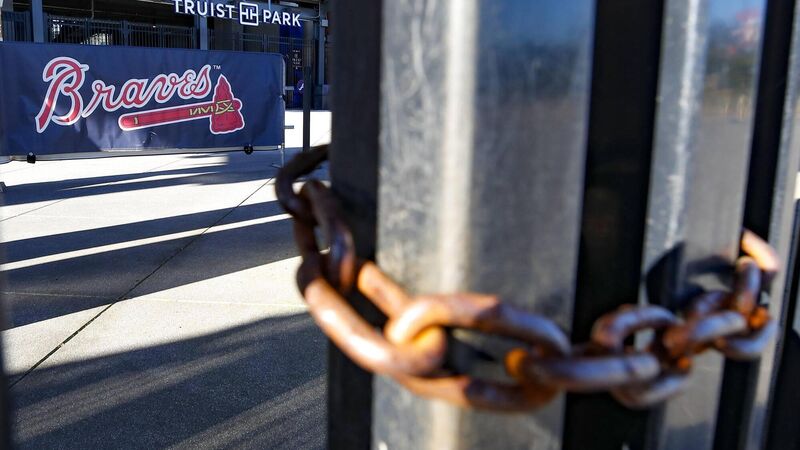Baseball's player lockout threatens winter escape

In Major League Baseball’s current tense lockout / Collective Bargaining Agreement negotiations, a deadline of this coming Monday has been set by the ballclub owners that could see the loss of regular season games in the Spring. The prevention of players to work and prepare for the new season is entering its third month and nobody can see a way back in.
Of all weeks, it seems trite beyond belief to focus on the political intrigue of athlete pay disputes happening in US sport.
This week has been a notable one for the back-and-forth of labour negotiations in America; for US women soccer players, it was a win and for baseball players and club owners, it has been an ongoing stalemate in a lockout instituted by the owners late last year. An appropriate state of affairs for a sport commonly regarded as boring.
It gets more and more difficult every year to evangelise for baseball. I got into another debate last Friday evening where I had to try once again to work through the historical and social constructs which gifted us this slower paced slice of Americana; where it doesn’t matter if nothing happens for two or three hours because there is so much more to consume at the ballpark on a lazy Sunday afternoon.
The age-old European expat crack was pitched at me, the one where the World Series gets to decide that the world champions are from North America and that only one of those teams is Canadian. It hadn’t occurred to me before that you can counter World Series with Champions League which pulls in more non-champion clubs than champions every season in order to stay viable and profitable. I was proud of that one and we ended up creating a social softball team which will have its opening day in April in Central Park.
But that was a miniscule victory in a tricky and adverse environment for the game of baseball where the NBA seems to add a new superstar to wow the kids every week and where the NFL has found similar success as it looks to elevate the Gen Z-style of hero through its various marketing platforms.
In Major League Baseball’s current tense lockout / Collective Bargaining Agreement negotiations, a deadline of this coming Monday has been set by the ballclub owners that could see the loss of regular season games in the Spring. The prevention of players to work and prepare for the new season is entering its third month and nobody can see a way back in.
This is particularly tough on large swathes of the national psyche. In the darkest days of February and March, the prospect of spring and the new baseball season offers a little bit of hope and solace. It's an ongoing but sustainable cliche that summer months are most definable by trips to the ballpark. No matter how badly your local team is doing, it's a necessary night out and it was a missed and cherished experience which was all the more welcome as the world opened back up a little last year.
In a country where sporting labour standoffs can lead to strikes or lockouts more often than seems viable, baseball had been enjoying the longest period of peace between its key constituents among the major four North American sports. This is the game’s first work stoppage since 1995.
Much more experienced observers are struggling to see any signs for optimism and the various terms of the so-called Collective Bargaining Agreement have so many tributaries of impact that the lawyers working for both sides are really earning their money.
Fundamentally, the MLB really operates towards the key interests of the 30 sets of owners who profit from the sport and who pay their players. It's not completely out of bounds to point out that players are passing through towards early retirement while the custodians of the game should be the owners of the clubs. In a perfect world, it would be acceptable for the players to work hard, earn well, entertain greatly and then move on with happy memories.
But of course the waters have always been muddied by the greed and mendacity of the large egos at the top of each pyramid. It was against that backdrop in the darker days of lower pay that the Major League Baseball Players Association - the union representing the interests and the rights of the professional players who endure a gruelling though rewarding season, year in, year out - was founded in the early 50s. It wasn't the first attempt at the concept of a players union and it wasn't officially recognised until the mid 60s but it has gone from strength to strength in a country where the workers union is under constant threat.
The MLBPA represents every player on the 40-man squads of the 30 major-league teams. In these current talks, there is an eight-player executive subcommittee charged with sitting down at the table with the MLB. Big names like Max Scherzer, Gerrit Cole, Francisco Lindor and the outspoken veteran free agent Andrew Miller have stepped up to the plate.
It all distills down to money, of course, and the easiest core disputes to mention here are issues such as the minimum wage, the Competitive Balance Tax (also known as the luxury tax) and revenue sharing.
While baseball is unique in that it doesn't have a salary cap - and it is an item that will never reach the negotiation table, so sacred is it to the entire ecosystem - it is ironically bogged down by the lowest minimum salary among the longer-standing American sports leagues.
According to The Athletic, the MLB minimum salary for players in 2021 was $570,500 while the minimum wage for a rookie in the NBA is just over $925,000 which moves to about $1.4 million in their second year. Ice hockey comes in at $750,000 and the NFL minimum is $660,000.
The heavyweights on the player's negotiating team want to elevate the pay of their young successors but they also have their own slice of the pie to figure out. A thorny issue is the “luxury tax” which is a threat that hangs over owners if they exceed the threshold for spending on player salaries. As with anything, there is a kernel of truth to the notion that the super rich Yankees and Dodgers shouldn't have greater access to the better players simply because they live in the most lucrative markets.
But the potential for abuse of this system is quite obvious. If needs be, owners can pay that tax (which ends up in a collective pot distributed to the other lower rung clubs) or they can also leverage the rule to ultimately pay the top stars less in order to be perceived as being compliant.
It is that latter point which the veterans are calling foul over. In 2017, the lowest Competitive Balance Tax threshold was $195 million and, under the terms of the last agreement, it had risen on schedule to $210 million last year. Which seems like a lot of money but if you are a top 20 or 30 player, you can expect to at least earn $30m a year which quickly reduces the available earnings for the rest of your teammates around whom you must negotiate if you want the entire team to be successful.
Last season, two teams were charged a luxury tax: the LA Dodgers paid out $32.65m on a $285.6m payroll and their near neighbors in Southern California, the San Diego Padres, paid $1.29 million in tax on a $216.5m payroll. Clearly any other owner with the ability to breach, decided against it and were able to justify doing so because those are the rules. As if playing by the rules was what got them there in the first place.
There is no doubt that the vast majority of players in the Major League are doing more than ok, at the very least. But when you consider that the MLB rakes in over $10b every year in spite of waning interest, you can understand that the people who are hugely responsible for that mammoth revenue will want to tighten up on their rights when the opportunity arises.
Equally so the owners; at best they can be regarded - as generously as possible - as taking their roles seriously: ensuring the long term viability of America's generations-old pastime. But of course it would be less naive to also reconcile with the fact that nobody driven by anything other than money and sound investment would stick around longer than was personally beneficial.
If we are to enjoy the hope of baseball coming back to us on time, maybe the men in the negotiating room should make way for the women. After six years of pushing, the US Women's National Team settled their longstanding equal pay lawsuit against the US Soccer Federation on Tuesday. Under the agreement, a group of several dozen current and former players will share $24 million in payments from US Soccer.
It was a justified reward for exhausting advocacy and another reason for baseball to worry about where the focus of young people - future players and consumers - will end up.









